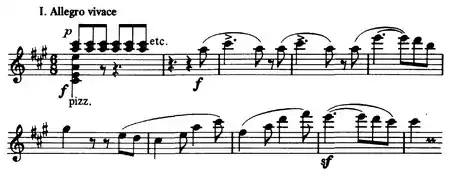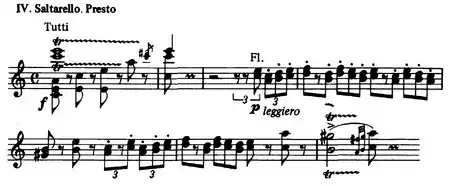Symphony No. 4 (Mendelssohn)
The Symphony No. 4 in A major, Op. 90, commonly known as the Italian,[1] is an orchestral symphony written by German composer Felix Mendelssohn.
| Symphony No. 4 in A major | |
|---|---|
| Italian | |
| by Felix Mendelssohn | |
 Drawing of the composer by Eduard Bendemann, 1833 | |
| Key | A major |
| Catalogue | Op. 90 |
| Composed | 1833, revised 1834 |
| Performed | 13 May 1833 |
| Published | 1851 |
| Movements | four |
History
The work has its origins, as had the composer's Scottish 3rd Symphony and The Hebrides overture, in the tour of Europe which occupied Mendelssohn from 1829 to 1831. Its inspiration is the colour and atmosphere of Italy, where Mendelssohn made sketches but left the work incomplete. Below is a snippet of a letter he wrote to his father:
This is Italy! And now has begun what I have always thought ... to be the supreme joy in life. And I am loving it. Today was so rich that now, in the evening, I must collect myself a little, and so I am writing to you to thank you, dear parents, for having given me all this happiness.[2]
In February he wrote from Rome to his sister Fanny,
The Italian symphony is making great progress. It will be the jolliest piece I have ever done, especially the last movement. I have not found anything for the slow movement yet, and I think that I will save that for Naples.
Mendelssohn completed the symphony in Berlin on 13 March 1833, in response to an invitation for a symphony from the London (now Royal) Philharmonic Society. He conducted the first performance himself in London on 13 May 1833 at a London Philharmonic Society concert. The Germania Musical Society of Boston gave the first performance in the United States, on 1 November 1851, with Carl Bergmann conducting.
Mendelssohn himself, however, remained dissatisfied with the symphony. He completed revisions to the work, particularly the last 3 movements, in July 1834. However, he never published the symphony during his lifetime. The symphony was published in 1851, in the original version given at the May 1833 premiere.[3] The scholar John Michael Cooper has investigated in details the history of Mendelssohn's revisions to the symphony.[4][5] Christopher Hogwood has edited a critical edition, published by Bärenreiter, of the symphony that includes the original standard version and Mendelssohn's revisions to the last 3 movements.
The published 1851 version is the standard edition performed generally by symphony orchestras. The revised version received its first commercial recording from Sir John Eliot Gardiner and the Vienna Philharmonic Orchestra in 1999,[6] and has received occasional live performances.[7] Edward Greenfield has commented on Mehdelssohn's changes between the two editions, in relation to the reasons for continuing performances of the standard edition:
Surprisingly for so perceptive a composer he undermined the original's freshness, smoothing over melodic lines (as in the Pilgrim's March) and extending linking passages. A fascinating comment on the danger of second thoughts after white-hot inspiration."[6]
Structure
The symphony is scored for 2 flutes, 2 oboes, 2 clarinets, 2 bassoons, 2 horns, 2 trumpets, timpani and strings. It is in four movements:
- Allegro vivace (A major)
- Andante con moto (D minor)
- Con moto moderato (A major)
- Presto and Finale: Saltarello (A minor)
The joyful first movement, in sonata form, is followed by an impression in the subdominant minor of D minor of a religious procession the composer witnessed in Naples. The third movement is a minuet in which French horns are introduced in the trio, while the final movement (which is in the minor key throughout) incorporates dance figurations from the Roman saltarello and the Neapolitan tarantella. It is among the first large multi-movement works to begin in a major key and end in the tonic minor, another example being Brahms's first piano trio.
A typical performance lasts about half an hour.
Notes
- The title is Mendelssohn's.
- Mendelssohn to Abraham Mendelssohn, from Venice, 10 October 1830.
- Ralph Blumenthal (2002-01-31). "Moving Mendelssohn Beyond Weddings; A Project to Rediscover a Life's Work". The New York Times. Retrieved 2020-11-26.
- Cooper, John Michael (April 1992). "'Aber eben dieser Zweifel': A New Look at Mendelssohn's Italian Symphony". 19th-Century Music. 15 (3): 169–187. doi:10.2307/746423.
- Stewart-MacDonald, R. H. (February 2005). "Review of Mendelssohn's 'Italian' Symphony by John Michael Cooper". Music & Letters. 86 (1): 129–135. JSTOR 3526043.
- Edward Greenfield (1999-05-14). "Other classical CD releases". The Guardian. Retrieved 2020-11-26.
- Barbara Eichner (2020-11-19). ""Die lustige Sinfonie, die ich auf das Land Italien mache": Zu Felix Mendelssohn Bartholdys Vierter Symphonie (programme notes for 20 November concert)" (PDF). Bavarian Radio Symphony Orchestra. Retrieved 2020-11-26.
External links
- Work details, Bärenreiter
- Symphony No. 4: Scores at the International Music Score Library Project
- Programme notes, Madison Symphony Orchestra, 26–28 September 2008, Michael Allsen



